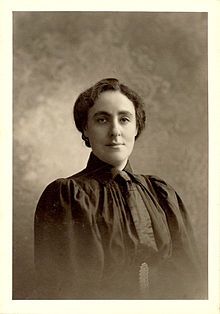Ray Frank
Rachel ("Ray") Frank (born April 10, 1861 in San Francisco , California , † October 10, 1948 ) was a prominent figure in Judaism in the United States .
Life
Frank was the daughter of the Jewish-Polish immigrants Bernard and Leah Frank. As a young woman, she taught Bible studies and Jewish history at the First Hebrew Congregation of Oakland Sabbath School. There she appeared as a public speaker and became known in the Jewish community of California. Among her pupils belonged to Gertrude Stein , with their students Judah Leon Magnes . At the same time, Frank was working as a correspondent for newspapers in San Francisco and Oakland . She published numerous articles in US Jewish press organs.
In the fall of 1890, Frank visited Spokane , Washington state . There she was asked to give a sermon on Rosh Hashanah . Her passionate sermon made a deep impression on the Christians and Jews present. She was the first official preacher in the USA, starting her career as "the Girl Rabbi of the Golden West," which helped to open up new avenues for women in Judaism. While she did not want to become a rabbi, her actions forced US Judaism for the first time to seriously consider ordaining women.
After all, Frank spent the 1990s giving travel lectures all over the west coast. B'nai B'rith lounges, reading societies and women's groups were their contacts. She preached in reform Jewish and Orthodox synagogues, officially participated in church services and read from the Scriptures. She was incorrectly referred to in the newspapers as the first female rabbi, and was offered several pulpits, but Frank insisted that she had never wanted to be ordained .
The newly formed Jewish communities very likely contributed to Frank's success. Had there been old institutions steeped in tradition and a deeply rooted leadership class here too, she would never have had the opportunity to preach. Her occasional preaching activity opened a gate, if only slightly, to the long journey of Jewish women to public religious leadership roles.
Secondary literature
- Simon Litman: Ray Frank Litman: A Memoir. In: Studies in American Jewish history. # 3. American Jewish Historical Society, New York 1957.
- R. Clar and WM Kramer: The Girl Rabbi of the Golden West. In: Western States Jewish History. 18, 1986, pp. 91-111, 223-236, 336-351.
- Ellen Umansky: Ray Frank. In: Michael Berenbaum , Fred Skolnik (Ed.): Encyclopaedia Judaica. Volume 7. 2nd Edition. Macmillan Reference USA, Detroit 2007, pp. 193-194.
- Pamela Susan Nadell: Women Who Would Be Rabbis: a history of women's ordination, 1889–1985. Beacon Press, Boston 1998.
- Fred Rosenbaum: San Francisco-Oakland: The Native Son. In: William M. Brinner, Moses Rischin: Like All the Nations? The Life and Legacy of Judah L. Magnes. State University of New York Press, 1987, ISBN 0-88706-507-4 .
Web links
- Women of Valor exhibit on Ray Frank ( Memento from December 15, 2009 in the Internet Archive ) in the Jewish Women's Archive
- Guide to the Ray Frank Litman Papers (PDF) in the American Jewish Historical Society, New York.
Individual evidence
- ^ Fred Rosenbaum: San Francisco-Oakland: The Native Son. P. 21.
| personal data | |
|---|---|
| SURNAME | Frank, Ray |
| ALTERNATIVE NAMES | Frank, Rachel (full name) |
| BRIEF DESCRIPTION | American preacher (Judaism) |
| DATE OF BIRTH | April 10, 1861 |
| PLACE OF BIRTH | San Francisco , California |
| DATE OF DEATH | October 10, 1948 |

